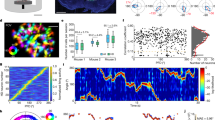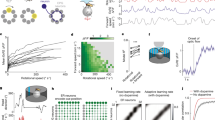Abstract
Motivated by experimental observations of the head direction system, we study a three population network model that operates as a continuous attractor network. This network is able to store in a short-term memory an angular variable (the head direction) as a spatial profile of activity across neurons in the absence of selective external inputs, and to accurately update this variable on the basis of angular velocity inputs. The network is composed of one excitatory population and two inhibitory populations, with inter-connections between populations but no connections within the neurons of a same population. In particular, there are no excitatory-to-excitatory connections. Angular velocity signals are represented as inputs in one inhibitory population (clockwise turns) or the other (counterclockwise turns). The system is studied using a combination of analytical and numerical methods. Analysis of a simplified model composed of threshold-linear neurons gives the conditions on the connectivity for (i) the emergence of the spatially selective profile, (ii) reliable integration of angular velocity inputs, and (iii) the range of angular velocities that can be accurately integrated by the model. Numerical simulations allow us to study the proposed scenario in a large network of spiking neurons and compare their dynamics with that of head direction cells recorded in the rat limbic system. In particular, we show that the directional representation encoded by the attractor network can be rapidly updated by external cues, consistent with the very short update latencies observed experimentally by Zugaro et al. (2003) in thalamic head direction cells.
Similar content being viewed by others
References
Allen GV, Hopkins DA,(1988) Mamillary body in the rat: A cytoarchitectonic, Golgi, and ultrastructural study. J. Comp. Neurol. 275(1): 39–64.
Allen GV, Hopkins DA,(1989) Mamillary body in the rat: Topography and synaptology of projections from the subicular complex, prefrontal cortex, and midbrain tegmentum. J. Comp. Neurol. 286: 311–336.
Allen GV, Hopkins DA,(1990) Topography and synaptology of mammillary body projections to the mesencephalon and pons in the rat. J. Comp. Neurol. 301: 214–231.
Amari SI,(1977) Dynamics of pattern formation in lateral-inhibition type neural fields. Bio. Cyber. 27: 77–87.
Arleo A, Gerstner W,(2001) Spatial orientation in navigating agents: Modeling head-direction cells. Neurocomput. 38–40(1–4): 1059–1065.
Bassett JP, Taube JS,(2001a) Lesions of the dorsal tegmental nucleus of the rat disrupt head direction cell activity in the anterior thalamus. Soc. Neurosci. Abst. 27: 852.29.
Bassett JP, Taube JS,(2001b) Neural correlates for angular head velocity in the rat dorsal tegmental nucleus. J. Neurosci. 21(15): 5740–5751.
Battaglia FP, Treves A,(1998) Attractor neural networks storing multiple space representations: A model for hippocampal place fields. Phys. Rev. E 58: 7738–7753.
Ben-Yishai R, Hansel D, Sompolinsky H,(1997) Traveling waves and the processing of weakly tuned inputs in a cortical network module. J. Comput. Neurosci. 4: 57–77.
Ben-Yishai R, Lev Bar-Or R, Sompolinsky H,(1995) Theory of orientation tuning in visual cortex. Proc. Natl. Aca. Sci. USA 92: 3844–3848.
Blair H, Cho TJ, Sharp PE,(1998) Role of the lateral mammillary nucleus in the rat head direction circuit: A combined single unit recording and lesion study. Neuron 21: 1387–1397.
Blair HT, Sharp PE,(1995) Anticipatory head direction signals in anterior thalamus: Evidence for a thalamocortical circuit that integrates angular head motion to compute head direction. J. Neurosci. 15(9): 6260–6270.
Brunel N,(2003) Dynamics and plasticity of stimulus-selective persistent activity in cortical network models. Cerebral Cortex 13: 1151–1161.
Brunel N, Wang X-J,(2001) Effects of neuromodulation in a cortical network model of object working memory dominated by recurrent inhibition. J. Comput. Neurosci. 11: 63–85.
Camperi M, Wang X-J,(1998) A model of visuospatial short-term memory in prefrontal cortex: Recurrent network and cellular bistability. J. Comput. Neurosci. 5: 383–405.
Chen LL, Lin L, Green EJ, Barnes CA, McNaughton BL,(1994) Head-direction cells in the rat posterior cortex. I. Anatomical distribution and behavioral modulation. Exp. Brain Res. 101: 8-23.
Cho J, Sharp PE,(2001) Head direction, place, and movement correlates for cells in the rat retrosplenial cortex. Behav. Neurosci. 115(1): 3–25.
Compte A, Brunel N, Goldman-Rakic PS, Wang X-J,(2000) Synaptic mechanisms and network dynamics underlying spatial working memory in a cortical network model. Cerebral Cortex 10: 910–923.
Degris T, Sigaud O, Wiener SI, Arleo A,(2004) Rapid response of head direction cells to reorienting visual cues: A computational model. Neurocomput. 58-60C: 675–682.
Ermentrout GB,(1998) Neural networks as spatio-temporal pattern-forming systems. Rep. Prog. Phys. 61: 353–430.
Georgopoulos AP, Schwartz A, Kettner RE,(1986) Neuronal population coding of movement direction. Science 233: 1416-1419.
Gonzalo-Ruiz A, Alonso A, Sanz JM, Llińas RR,(1992) Afferent projections to the mammillary complex of the rat, with special reference to those from surrounding hypothalamic regions. J. Comp. Neurol. 321: 277–299.
Goodridge JP, Dudchenko PA, Worboys KA, Golob EJ, Taube JS,(1998) Cue control and head direction cells. Behav. Neurosci. 112(4): 749–761.
Goodridge JP, Taube JS,(1995) Preferential use of landmark navigational system by head direction cells in rats. Behav. Neurosci. 109: 49–61.
Goodridge JP, Taube JS,(1997) Interaction between the postsubiculum and anterior thalamus in the generation of head direction cell activity. J. Neurosci. 17(23): 9315–9330.
Goodridge JP, Touretzky DS,(2000) Modeling attractor deformation in the rodent head-direction system. J. Neurophysiol. 83(6): 3402–3410.
Gutkin BS, Laing CR, Colby CL, Chow CC, Ermentrout GB,(2001) Turning on and off with excitation: The role of spike time asynchrony and synchrony in sustained neural activity. J. Comput. Neurosci. 11: 121–134.
Hansel D, Sompolinsky H,(1998) Modeling feature selectivity in local cortical circuits. In: C Koch, I Segev eds. Methods in Neuronal Modeling, 2nd ed. MIT press, Cambridge, MA.
Jahr CE, Stevens CF,(1990) Voltage dependence of NMDA-activated macroscopic conductances predicted by single-channel kinetics. J. Neurosci. 10: 3178–3182.
Kali S, Dayan P,(2000) The involvement of recurrent connections in area CA3 in establishing the properties of place fields: A model. J. Neurosci. 20(19): 7463–7477.
Knierim JJ, Kudrimoti HS, McNaughton BL,(1998) Interactions between idiothetic cues and external landmarks in the control of place cells and head direction cells. J. Neurophysiol. 80: 425–446.
Koulakov AA, Raghavachari S, Kepecs A, Lisman JE,(2002) Model for a robust neural integrator. Nature Neurosci. 5: 775-782.
Laing CR. Chow CC,(2001) Stationary bumps in networks of spiking neurons. Neural Comput. 13: 1473–1494.
Liu R, Chang L, Wickern G,(1984) The dorsal tegmental nucleus: An axoplasmic transport study. Brain Res. 310: 123-132.
Llinás RR, Alonso A,(1992) Electrophysiology of the mammillary complex in vitro. I. Tuberomammillary and lateral mammillary neurons. J. Neurophysiol. 68(4): 1307–1320.
Lukashin AV, Georgopoulos AP,(1993) A dynamical neural network model for motor cortical activity during movement: Population coding of movement trajectories. Biol. Cyber. 69: 517–524.
Matthews BL, Campbell KA, Deadwyler SA,(1988) Rotational stimulation disrupts spatial learning in fornix-lesioned rats. Behav. Neurosci. 102: 35–42.
McNaughton BL, Chen LL, Markus EJ (1991) Dead reckoning, landmark learning, and the sense of direction: A neurophysiological and computational hypothesis. J. Cog. Neurosci. 3: 190–202.
Mizumori SJY, Williams JD,(1993) Directionally selective mnemonic properties of neurons in the lateral dorsal nucleus of the thalamus of rats. J. Neurosci. 13: 4015-4028.
Ranck JBJ,(1984) Head-direction cells in the deep cell layers of dorsal presubiculum in freely moving rats. Soc. Neurosci. Abst. 10: 599.
Redish AD, Elga AN, Touretzky DS,(1996) A coupled attractor model of the rodent head direction system. Network 7(4): 671–685.
Redish AD, Touretzky DS,(1997) Cognitive maps beyond the hippocampus. Hippocampus 7(1): 15–35.
Rubin J, Terman D, Chow C,(2001) Localized bumps of activity sustained by inhibition in a two-layer thalamic network. J. Comput. Neurosci. 10: 313–331.
Samsonovich A, McNaughton BL,(1997) Path integration and cognitive mapping in a continuous attractor neural network model. J. Neurosci. 17(15): 5900–5920.
Sharp PE, Blair HT, Cho J,(2001) The anatomical and computational basis of the rat head-direction cell signal. Trends Neurosci. 24(5): 289–294.
Sharp PE, Tinkelman A, Cho J,(2001) Angular velocity and head direction signals recorded from the dorsal tegmental nucleus of gudden in the rat: Implications for path integration in the head direction cell circuit. Behav. Neurosci. 115(3): 571-588.
Shibata H,(1987) Ascending projections to the mammillary nuclei in the rat: A study using retrograde and anterograde transport of wheat germ agglutinin conjugated to horseradish peroxidase. J. Comp. Neur. 264: 205–215.
Skaggs WE, Knierim JJ, Kudrimoti HS, McNaughton BL,(1995) A model of the neural basis of the rat’s sense of direction. In: G Tesauro, DS Touretzky TK, Leen (eds.) Advances in Neural Information Processing Systems 7, MIT Press, Cambridge, MA, pp. 173–180.
Somers DC, Nelson SB, Sur M,(1995) An emergent model of orientation selectivity in cat visual cortical simple cells. J. Neurosci. 15: 5448–5465.
Song P, Wang X-J,(2003) A three-population attractor network model of rodent head direction system. Soc. Neurosci. Abst., 939. 3.
Song P, Wang X-J,(2004) Time integration by moving ‘hill of activity’: A spiking neural model without recurrent excitation of the head-direction system. To appear in J. Neurosci.
Stackman RW, Taube JS,(1998) Firing properties of rat lateral mammillary single units: Head direction, head pitch, and angular head velocity. J. Neurosci. 18(21): 9020-9037.
Taube JS,(1995) Head direction cells recorded in the anterior thalamic nuclei of freely moving rats. J. Neurosci. 15(1): 70–86.
Taube JS,(1998) Head direction cells and the neurophysiological basis for a sense of direction. Prog. Neurobiol. 55: 225-256.
Taube JS, Bassett JP,(2003) Persistent neural activity in head direction cells. Cerebral Cortex 13: 1162–1172.
Taube JS, Muller RU,(1998) Comparisons of head direction cell activity in the postsubiculum and anterior thalamus of freely moving rats. Hippocampus 8: 87–108.
Taube JS, Muller RI, Ranck JBJ,(1990a) Head direction cells recorded from the postsubiculum in freely moving rats. I. Description and quantitative analysis. J. Neurosci. 10: 420-435.
Taube JS, Muller RI, Ranck JBJ,(1990b) Head direction cells recorded from the postsubiculum in freely moving rats. II. Effects of environmental manipulations. J. Neurosci. 10: 436-447.
Tsodyks M, Sejnowski T,(1995) Associative memory and hippocampal place cells. Int. J. Neur. Syst. 6: 81–86.
Wang X-J,(2001) Synaptic reverberation underlying mnemonic persistent activity. Trends Neurosci. 24(8): 455–463.
Wiener SI,(1993) Spatial and behavioral correlates of striatal neurons in rats performing a self-initiated navigation task. J. Neurosci. 13: 3802–3817.
Wiener SI, Arleo A,(2004) Persistent activity in limbic system neurons: Neurophysiological and modeling perspectives. J. Physiol. Paris 97(4–6): 547–555.
Wirtshafter D, Stratford TR,(1993) Evidence for GABAergic projections from the tegmental nuclei of Gudden to the mammillary body in the rat. Brain Res. 630: 188–194.
Xie X, Hahnloser RHR, Seung HS,(2002) Double-ring network model of the head direction system. Phys. Rev. E 66: 041902–1–9.
Zhang K,(1996) Representation of spatial orientation by the intrinsic dynamics of the head-direction cell ensemble: A theory. J. Neurosci. 16(6): 2112–2126.
Zugaro MB, Arleo A, Berthoz A, Wiener SI,(2003) Rapid spatial reorientation and head direction cells. J. Neurosci. 23(8): 3478–3482.
Zugaro MB, Berthoz A, Wiener SI,(2001) Background, but not foreground, spatial cues are taken as references for head direction responses by rat anterodorsal thalamus neurons. J. Neurosci. 21: RC154(1–5).
Author information
Authors and Affiliations
Rights and permissions
About this article
Cite this article
Boucheny, C., Brunel, N. & Arleo, A. A Continuous Attractor Network Model Without Recurrent Excitation: Maintenance and Integration in the Head Direction Cell System. J Comput Neurosci 18, 205–227 (2005). https://doi.org/10.1007/s10827-005-6559-y
Issue Date:
DOI: https://doi.org/10.1007/s10827-005-6559-y




